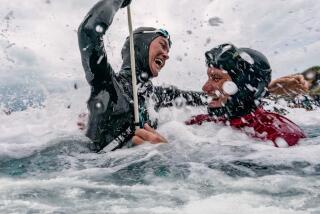Reliving the Achille Lauro Tragedy : NEW MINISERIES ON HIJACKING USES THE ACTUAL SHIP AND ITS CREW
- Share via
All in the name of realism. That’s why 10%-$1 million-of the budget of “Voyage of Terror: The Achille Lauro Affair” was spent to rent the real Achille Lauro.
For those with short memories: The Achille Lauro was the Italian cruise ship hijacked five years ago in the Mediterranean by four Palestinian terrorists who murdered Leon Klinghoffer, a wheelchair-bound American.
“Voyage of Terror” stars Burt Lancaster and Eva Marie Saint as Klinghoffer and his wife, Marilyn. The two-part movie airs Tuesday and Wednesday at 8 p.m. on KTLA. This first presentation of the syndicated Tribune Premiere Network is a German, Italian and French co-production that will air in Europe later this year.
Re-creating the events for the $10-million miniseries proved to be not only costly but difficult and even dangerous for the producers, crew and cast. Troubles started with acquiring use of the actual Achille Lauro.
“When the ship was owned by the (Italian) government, there was going to be no cost,” said George Paris, vice president of Tribune Entertainment. “But then the government sold the ship, and it became a commercial venture. The new owner obviously couldn’t give up the ship and interrupt its travel itinerary.”
The original captain served as the technical adviser, and several of the same crew members worked for the film’s voyage and appear as themselves. For one week, the production took to sea on the same route as the ill-fated journey with 300 extras to film the violent sequences and terrorist activities. For the following 2 1/2 weeks, the crew and staff shared the ship with real tourists.
David Lawrence, the American producer, remembered the original crew members were distraught when it came time to re-enact the hijacking. “There were tears rolling down their cheeks,” he said. “We were re-creating things they had lived through.”
“It was very eerie,” said Paris.
Before production began on “Voyage of Terror,” Lawrence talked with a good friend who was involved with “The Hijacking of the Achille Lauro,” NBC’s version of the event that had been shot in Australia and aired in February, 1989.
“He was amazed we had gotten the Achille Lauro and had gotten the complete cooperation of the Italian government,” he said. “They had been warned to keep away from this project, because it was a life-threatening situation.”
“There were so many political aspects to consider,” said Italian producer Fabrizio Castellani. “For instance, the American partner cared about the emotional aspects of the event, and the Italian partner looked to the political aspects. It was a very delicate subject.”
The producers took every precaution against terrorist attacks during the filming. “There were guards on duty,” said Paris. The cast was also not allowed to disembark at several ports.
“We kept the whole thing under wraps,” said Lawrence. “When Burt Lancaster and Eva Marie Saint came to Rome-they are big stars there-we never released any information about their arrival. There were no interviews, and that held true until they were safe.”
Nevertheless, said Lawrence, some of the Egyptian and Israeli actors were hassled by the port authorities in various cities. “I guess they had a right to be fearful if they thought they could possibly be terrorists,” he said. “We had an American actor who was Arabic by heritage who was awakened by the authorities in the middle of the night. We finally convinced them he was legitimate.”
The production also received a “fair amount” of pressure from governmental agencies of several countries because they thought “Voyage of Terror” showed the terrorists in a favorable light.
“I heartily disagree with that,” said Lawrence. “We are not saying the terrorists were good guys. We try to express their viewpoint. It’s very difficult when you are juggling international situations.”
“Great care was taken not to paint a picture of the terrorists as four irresponsible terrorists who were out just to terrorize, but four young people-these were all kids in their teens and early 20s-who felt they were on a mission to help their countrymen,” said Paris. “There was great care taken in trying to paint an accurate picture of the events, feelings and attitudes of the people involved. Those four kids looked at themselves not as terrorists but as patriots.”
More to Read
The complete guide to home viewing
Get Screen Gab for everything about the TV shows and streaming movies everyone’s talking about.
You may occasionally receive promotional content from the Los Angeles Times.







